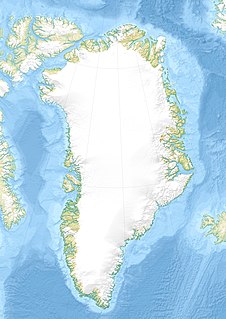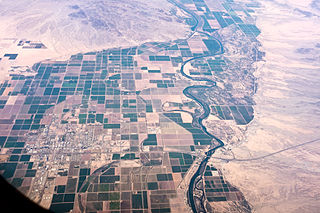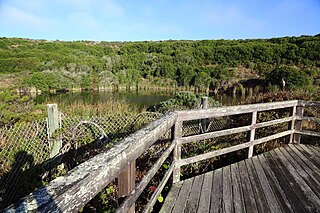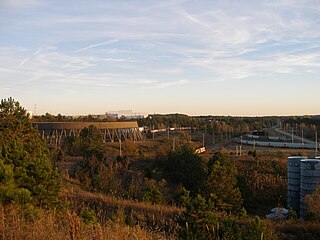
Whistling Straits is one of two 36-hole links-style golf courses associated with Destination Kohler, a luxury golf resort owned and operated by the Kohler Company in Kohler, Wisconsin. The other course is Blackwolf Run, located in the Village of Kohler. The Whistling Straits complex is located north of Sheboygan, in the unincorporated community of Haven in the Town of Mosel in Sheboygan County. Whistling Straits is separated into two courses, the Straits Course and the Irish Course.

The Shoreham Nuclear Power Plant was a completed General Electric nuclear boiling water reactor located adjacent to Long Island Sound in East Shoreham, New York.
The Black Fox Nuclear Power Plant was a nuclear power plant proposed by the Public Service Company of Oklahoma (PSO) in May 1973. It was cancelled in 1982.
The WS-125 was an American super long-range strategic bomber project during the Cold War to develop a nuclear-powered aircraft.

Haven is an unincorporated community in the town of Mosel in Sheboygan County, Wisconsin, United States. The community is located east of I-43 between Sheboygan, Wisconsin and Cleveland, Wisconsin.
The William States Lee III Nuclear Station was a planned two-unit nuclear power plant in Cherokee County, South Carolina. Duke Energy filed the Combined Construction and Operating License (COL) application for the plant on December 13, 2007 to the NRC. On December 19, 2016, the NRC issued two Combined Licenses authorizing Duke to build and operate two AP1000 reactors at the site.
The Alan R. Barton Nuclear Plant was a proposed commercial nuclear power plant in central Alabama.

Project Iceworm was a top secret United States Army program of the Cold War, which aimed to build a network of mobile nuclear missile launch sites under the Greenland ice sheet. The ultimate objective of placing medium-range missiles under the ice — close enough to strike targets within the Soviet Union — was kept secret from the Government of Denmark. To study the feasibility of working under the ice, a highly publicized "cover" project, known as Camp Century, was launched in 1960. Unstable ice conditions within the ice sheet caused the project to be canceled in 1966.

Between 2007 and 2009, 13 companies applied to the Nuclear Regulatory Commission for construction and operating licenses to build 31 new nuclear power reactors in the United States. However, the case for widespread nuclear plant construction has been hampered due to inexpensive natural gas, slow electricity demand growth in a weak US economy, lack of financing, and safety concerns following the Fukushima nuclear disaster in 2011.

The Sundesert Nuclear Power Plant was a proposed California nuclear power station, formally submitted in 1976. Facing firm opposition from the state's Governor Jerry Brown and denied a permit by a state agency, plans for the construction of the power facility were rejected in 1978 after 100 million dollars had been spent towards its construction. The Sundesert proposal was the last major attempt to build a nuclear plant in California.

The Bodega Bay Nuclear Power Plant was a proposed Northern California nuclear power facility that was stopped by local activism in the 1960s and never built. The foundations, located 2 miles (3.2 km) west of the active San Andreas Fault, were being dug at the time the plant was cancelled. The action has been termed "the birth of the anti-nuclear movement."

The Yellow Creek Nuclear Plant is a canceled nuclear power plant project near Iuka, Mississippi. It was originally planned to have two 1,350-MW (output) reactors operated by the Tennessee Valley Authority (TVA). The steam turbine-generator sets were provided by General Electric.
The Montague Nuclear Power Plant was a proposed nuclear power plant to be located in Montague, Massachusetts. The plant was to consist of two 1150 MWe General Electric boiling water reactors. The project was proposed in 1973 and canceled in 1980, after $29 million was spent on the project.
The Allens Creek Nuclear Power Plant was a proposed nuclear power plant to be located at Wallis, Texas, less than 50 miles from the western edge of Houston. The plant, consisting of two 1,150 MWe General Electric boiling water reactors, was ordered by Houston Lighting and Power Company (HL&P) in 1973, but public opposition, fueled in part by press coverage of problems at other nuclear plants around the country, led to lengthy public hearings and court action. In the meantime, construction costs escalated and the plant was officially canceled in 1982.
The Atlantic Nuclear Power Plant was a proposed floating nuclear power plant located off the coast of New Jersey. It was proposed in the 1970s by the Public Service Electric and Gas Company. Two Westinghouse 1,150 MWe (net) pressurized water reactors were ordered in 1972, and another two Westinghouse 1,150 MWe (net) reactors were ordered in 1973. The four unit power plant proposal was canceled in 1978.
The Blue Hills Nuclear Power Plant was a proposed commercial nuclear power plant 20 miles northeast of Jasper, Texas. It was proposed in the 1970s by the Gulf States Utilities Company. One 918 MWe pressurized water reactor was ordered in 1973, and an additional 918 MWe reactor was ordered in 1974 from Combustion Engineering. The two unit power plant proposal was canceled in 1978.
The Erie Nuclear Power Plant was a proposed nuclear power plant to be located 9 miles (14 km) southeast of Sandusky, Ohio. It was proposed in 1976 by Ohio Edison for the Central Area Power Coordination (CAPCO). The plant was to consist of two Babcock & Wilcox 1,267 megawatt reactors. Unit 1 was scheduled to be complete in 1986, Unit 2 in 1988. Preliminary work was canceled in 1980 due to new federal requirements placed on nuclear plants that make their construction more expensive and by a drop in anticipated customer energy demand.
The Forked River Nuclear Power Plant was a proposed nuclear power plant in Lacey Township in Ocean County, New Jersey. It was proposed as a single 1,070 MW reactor in 1969 to be built by Combustion Engineering and operated by Jersey Central Power and Light. The facility would have been located on a site between JCP&L's existing Oyster Creek Nuclear Generating Station and the Garden State Parkway. Unlike the Oyster Creek Plant, the Forked River Plant would have a cooling tower to prevent the release of hot water into Oyster Creek and Barnegat Bay.
The Greene County Nuclear Power Plant was proposed in 1974 by the Power Authority of the State of New York. A single 1,212 MWe Babcock & Wilcox pressurized water reactor was to be built approximately 5 miles south of Catskill, New York on the western shore of the Hudson River, but the plant proposal was canceled in 1979, largely due to concerns over social and economic disruptions to the local communities.
The Bailly Nuclear Power Plant was a nuclear power plant project to be located near the Indiana Dunes National Lakeshore in Porter County, Indiana, United States. The project was proposed by the Northern Indiana Public Service Company (NIPSCO) in 1967; however, it was cancelled in 1981.








